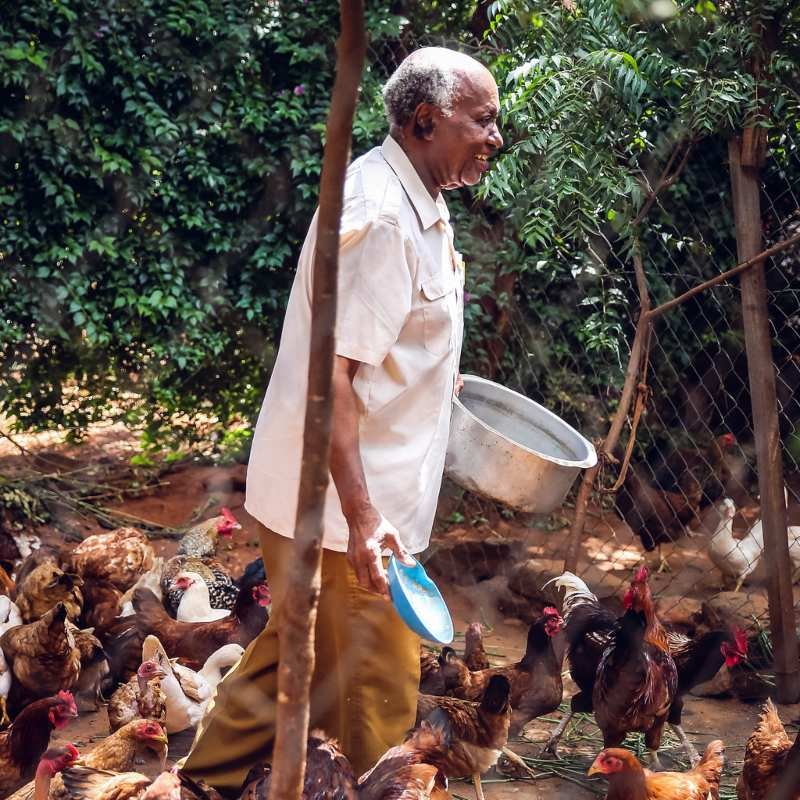Agricultural Development
Most Shighatini families are subsistence farmers. That fact translates into a financial challenge for the parish as they try to maintain buildings and pay salaries using offerings from parish farm families who also have medical bills and school fees.
To help become more self-supporting, the Shighatini Parish asked Bethesda for assistance with three priority projects to boost farmers’ incomes: poultry (broilers and layers), dairy (value-added milk processing), and corn (production and storage). In addition, they established a 10–member Agriculture Club of local farmers willing to work toward their entrepreneurship goals.
Chickens and eggsThe local market for broilers and eggs is strong. Customers are ready to buy, even at their doorsteps. Plus, the amount of time between investment and return is short — making his one of the top priorities for a demonstration project.
Shighatini goal:
Each demonstration farmer buys 100 hybrid chicks, sells the broilers at eight weeks, and sells eggs (once production starts) for about one year.
ETI role:
Jump-start the process by providing loan funds so each of the 10 farmers can buy chicks.
Corn production and storage
Shighatini goals:
Establish better corn storage methods to get maximum benefit from each harvest. Obtain hybrid seed and fertilizer in hopes of increasing yields to at least 100 bushels per acre.
ETI role:
Provide funds for purchasing hybrid seed and fertilizer plus equipment and instructions for establishing a 10 square-meter demonstration plot. Carl Bern, one of Bethesda’s’ Agricultural Ministries Team (a professor in agricultural engineering), is exploring options for improved storage recommendations.
All corn grown in the parish is for human consumption. Current harvests, however, provide only about 25 bushels per acre—too little to provide both food for the farmers’ families plus some surplus to sell. Harvested corn is usually stored in cloth bags or large barrels and typically becomes heavily infested with insects.
Shighatini goals:
Establish better corn storage methods to get maximum benefit from each harvest. Obtain hybrid seed and fertilizer in hopes of increasing yields to at least 100 bushels per acre.
ETI role:
Provide funds for purchasing hybrid seed and fertilizer plus equipment and instructions for establishing a 10 square-meter demonstration plot. Carl Bern, one of Bethesda’s’ Agricultural Ministries Team (a professor in agricultural engineering), is exploring options for improved storage recommendations.
Pasteurized milk and local yogurtThis is a three-part effort focused on helping farmers develop two new and marketable products (pasteurized milk and locally-made yogurt), plus increasing milk yields by improving the cows’ diets.
Bethesda role:
During last spring’s visit, Arne Paulsen showed the farmers (men and women) how to use the two one-gallon pasteurizing machines that Bethesda donated. He also demonstrated how to use some of the pasteurized milk to make yogurt.
To help improve grassland forage, the Bethesda team delivered 15 elephant grass rhizomes from the University of Georgia and helped farmers plant them in a nursery plot. Once the grasses reach transplant size, they can be moved to area farms and planted with climbing desmodium, a native legume, to provide a better forage diet for the dairy cows.
Shighatini results:
At last report the locally-made yogurt is being sold at the weekly parish auction for a “very good price.” Heifer International has asked Shighatini for some of the elephant grass rhizomes to be used in other villages throughout Tanzania.
The Bethesda Agricultural Ministries Team’s main goal is to raise the income of the Shighatini farmer and help facilitate the transition from a “barter” economy to a ”cash” economy. Once incomes start to rise, more children will be able to go to school, the Shighatini people will be able to improve their diet with the eggs and broiler production.

